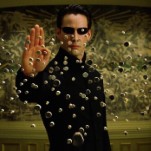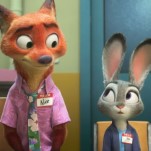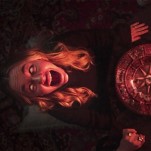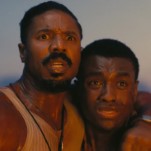Avengers #1 vs. DC Nation #0: Battle of the Summer Kickoff Comics
Marvel & DC Comics Both Released Major Jumping-On Points This Week. Which One Came Out on Top?
Main Art by Jorge Jimenez & Alejandro Sanchez/ Ed McGuinness, Mark Morales & Justin Ponsor
Listen, we don’t like critically comparing comics. Every alchemical combination of art and words is its own beast, and there’s rarely anything to be gained from stacking two different books against each other. But sometimes we find ourselves hopeless against the siren call of #content, and we just couldn’t pass up the timing of DC Comics and Marvel Comics both releasing major jumping-on points this week—especially when we discovered the near-identical final pages of both issues. After careful consideration, we decided to judge Avengers #1 and DC Nation #0 in three different categories and declare, definitively, which Big Two publisher produced a better summer kickoff comic. Fear not: despite calling out the matching final splashes above, there are no substantial spoilers in the assessments below.
![]()
Category #1: Accessibility
DC Nation’s entire purpose is drawing readers—new, casual or dedicated—to DC Comics’ major summer comics. Avengers #1, released the week after Avengers: Infinity War made more money than God at the box office, is the official launch of Marvel’s “Fresh Start” initiative to re-center its most iconic characters. So did either book achieve its goal?

DC Nation #0 Main Cover Art by Jorge Jimenez & Alejandro Sanchez
DC Nation is comprised of three different short comics, and unsurprisingly ends up with three varying levels of accessibility. Tom King and Clay Mann’s Joker story, “Your Big Day,” ably sets up Batman’s summer event—his impending wedding—and the tension of Joker’s likely presence at the ceremony. King’s approach to the Clown Prince of Crime still doesn’t ring quite right, but all you need to know to follow DC Nation’s first entry is “Joker = Unhinged,” which most potential readers have memorized by this point.
Brian Michael Bendis and José Luis García-López’ Superman tale, “Office Space,” unfortunately weighs down the middle of the issue. While the duo eventually get around to a vague hook involving a new character, Bendis’ trademark patter runs rampant over Garcia-López’ iconic art, and Bendis’ stammering, insecure take on Clark Kent may frustrate readers. There’s also a mystery concerning Lois’ presence that comes across as more confusing than enticing. Despite “Office Space” being only Bendis’ second story for DC Comics, readers are likely to feel like they’re already behind on the plot. It’s clear where readers can find Bendis’ Superman next—The Man of Steel mini-series debuting later this month—but not why they’d want to.
Finally, Scott Snyder, James Tynion IV, Joshua Williamson and Jorge Jimenez succeed completely in setting up the utterly bonkers Justice League: No Justice mini-series with a 10-page prelude. While No Justice ostensibly spins out of Metal, any exposition is quickly handled in this short. “Mystery,” “Wonder” and “Wisdom” definitely aren’t “cosmic energies,” as the script claims, but this bombastic tale taps into the same wide-eyed, high-concept awe of Steve Orlando’s just-concluded JLA series, or even Grant Morrison and Howard Porter’s all-time best run from the ‘90s. Snyder, Tynion IV, Williamson and Jimenez set up the entire mismatched cast, explain everything you need to know about the premise and end on a major tease that readers can follow into next week’s Justice League: No Justice #1.

Avengers #1 Cover Art by Ed McGuinness, Mark Morales & Justin Ponsor
On the other side of the aisle, Avengers #1 opens not with any of the stars of Infinity War, but with a gathering of super heroes from one million years in the past. Even the most casual fan should recognize most of these mantle-bearers (although Starbrand Not-Hulk may confuse folks unfamiliar with Jonathan Hickman’s weird run on the title), but it’s still a potentially alienating choice. Avengers #1 technically spins out of last fall’s Marvel Legacy #1, and it’s only this opening sequence that feels reliant on previous knowledge. Once Jason Aaron moves the plot into the modern day, the combination of Tony Stark, Steve Rogers and Thor Odinson feels like a warm embrace from an old friend. Aaron catches readers up with each hero’s status quo nicely, but Tony’s suggestion that newer heroes should be taking up the Avengers banner might sting, since Marvel seems to be shuffling away its younger, more diverse characters in favor of highlighting the old guard once again.
Still, the structure of the rest of the issue, which finds heroes operating independently or in small combinations, brings to mind the expert cast juggling of Infinity War, and gives readers an opportunity to meet each team member in his or her element. The stakes of the core conflict are firmly established by issue’s end, and the final page directs readers to Avengers #2, which hits stands in just two weeks.
Curiously, our review copy had in-house ads for the new Thor, The Immortal Hulk and Tony Stark: Iron Man ongoing series (as well as X-Men Gold’s upcoming wedding issue), but not Captain America, Black Panther, Doctor Strange or The Life of Captain Marvel. Given that Cap and Black Panther are both written by Ta-Nehisi Coates, Captain Marvel has a film on the way and Doctor Strange played a major role in Infinity War, it’s disappointing that Marvel didn’t at least include a last-page ad directing readers to every individual ongoing. The Robbie Reyes Ghost Rider and Jennifer Walters Hulk/She-Hulk also have recent, accessible, high-quality standalone runs available in trade form, and Marvel could have carved out space to point curious readers toward more information on the series’ non-MCU characters. (And let’s not even discuss the Agents of S.H.I.E.L.D. ad that ruins the book’s best page turn.)
-

-

-

-

-

-

-

-

-

-

-

-

-

-

-

-

-

-

-

-

-

-

-

-

-

-

-

-

-

-

-

-

-

-

-

-

-

-

-

-












































